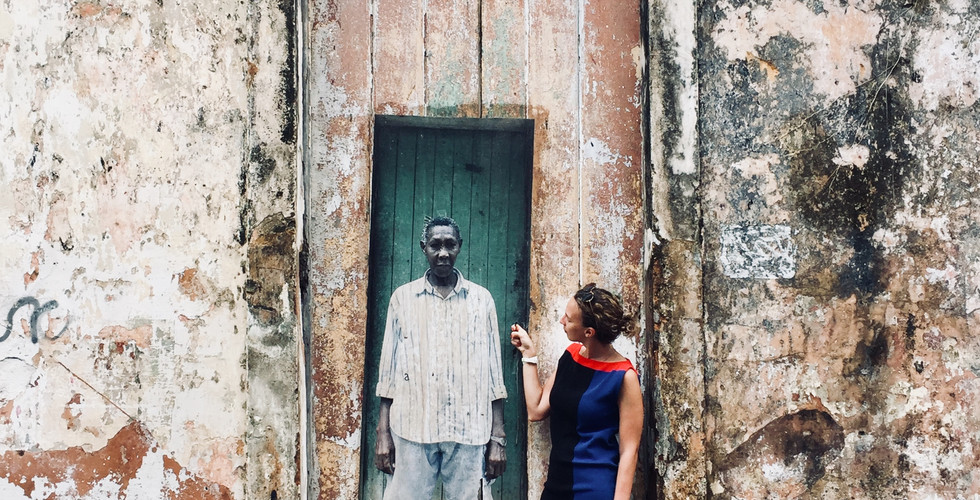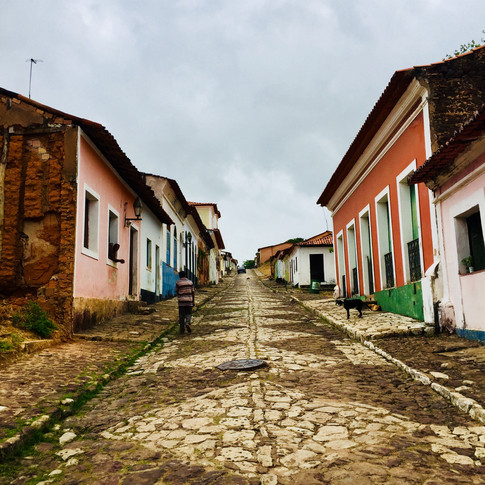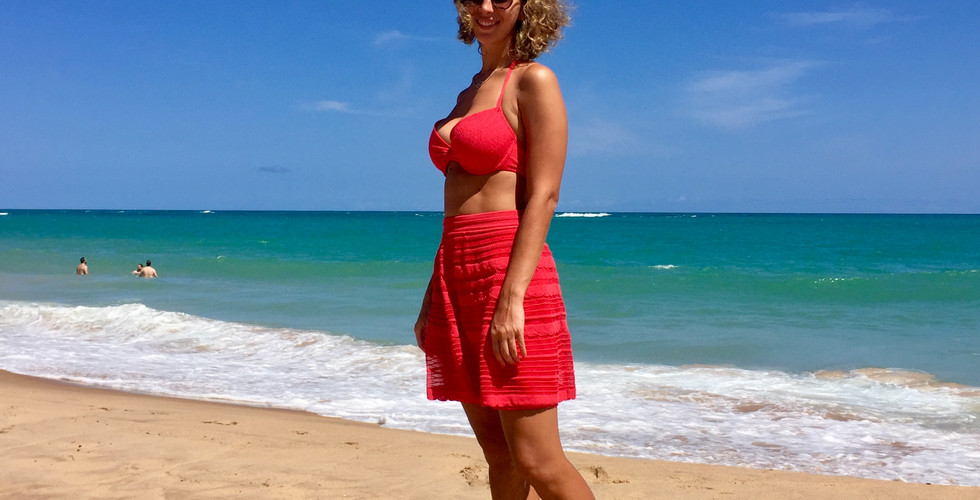BRAZIL MY DREAM. CHAPTER 2
- Marina Chaffanjon
- Dec 9, 2018
- 7 min read
Updated: Jan 29, 2021
The first thing that surprises in the Brazilian urban culture, at least that was the case for me, a girl living in Paris, is the variety of bright colors that people paint their houses in as the means of self-expression. In a big modern megapolis or in a small fisher village you will see at least a few streets filled up with houses in all rainbow colors. This gay picture is always pleasant for the European eye used to natural gray / beige architecture.

Olinda, Pernambuco state
Our first and last stop in Brazil was the city called Olinda where we arrived on Sunday morning direct from the airport. "Linda" is translated from Portuguese as "beautiful" and according to the legend, when the Portuguese colonizers arrived to Brazil and saw the view from the hill on the ocean, they were so astonished by the beauty of this land that this amazement got stuck forever in the city name "Oh, beautiful!". Olinda is more of a small suburb town of Recife than an independent city. Located on a hill overlooking the sea, it is penetrated by lots of two-storey colonial architecture houses all in different colors. The city is known for its galleries (all of which were closed, alas, both times that we came to Olinda as it was on Sundays), but the love for art apparently cannot be contained in 4 walls and it goes beyond them. All around the city you would see beautiful street art graffitis on the facades of the houses.
When we walked around the city during the day, we had an impression we were in a ghost town - everything was closed and we were almost the only people out in the streets. It was partly because it was Sunday, partly because Brazilians were probably doing their siesta (although it was cloudy and the temperature was around +27, not too hot that is), but apparently this tourist town only wakes up at night. Around 7 PM all of a sudden people started going out. From where? I don't know. In this tourist town apart from galleries one can only find hotels, I thought. My guess is that these were Recife citizens coming to Olinda for its unique party spirit. They were slowly swamping the streets drinking beer and talking. The music started abruptly with the beat of the drums and then we saw a procession of people going down the street all dressed in white, playing with different percussion instruments a particular rhythm that makes your blood pump to the beat of the sound. This particular music Maracatu is typical for this region of Brazil and is practiced primarily around Carnival. Although we were there two months before, we had a chance to witness one of the rehearsals that happens every Sunday starting from December. So without even knowing it, we took part in a mini-carnival that is by the way considered to be one of the best ones in Brazil after Rio and is also free. After the first white parade passed, the blue one came and then we saw a bit farther the green one. By that time the whole city had turned into a big dance floor with its streets pulsing with the music. It was magical! A complete immersion in the local culture right from the first day.
São Luís, Maranhão state
After the first night in Olinda, we took a taxi back to the Recife airport and jumped on the plane that took us to São Luís, an old colonial city that owes its name to the French King Luis XIII, under whose reign the first French colonizers settled on this land. They didn't stay there for too long and apart from the name, they did not really leave any other visible trace as the city actually has the largest heritage of colonial Portuguese architecture in all Latin America. According to Wikipedia, it is well preserved, but, honestly, it evokes quite the contrary feelings. The greatness and sophistication of the city have faded with the years and you can only guess, looking at the ruined facades, what luxury they used to hide inside once upon a time...
We had a chance to stay in a hotel that is a wonderful example of the glorious past and a sad, though beautiful, monument of the Portuguese heritage - Pousada Portas da Amazonia. As the Pousada is located right in the centre of the old town, it suffises to go out of your room to find yourself in a very authentic atmosphere of a Brazilian provincial night life: a town square full of bars, where locals consume nothing but a very cheap beer and, exceptionally, caipirinha, street demonstrations of capoeira and kids playing around - all this in a very casual and relaxed atmosphere of a summer weekend, even in the middle of the week.

We came back to São Luís after our excursion to the National Parc of Lençóis Maranhenses just for Christmas. On the Christmas eve we went out for a walk in the morning in the quest for festive spirit: I have to say, even though you know that around the equator it is still hot and humid on Christmas, psychologically it is hard to put yourself in a festive mood when you don't have snow flakes falling and it is not cold and dark. However, it is definitely not the case for Brazilians who are perfectly comfortable celebrating Christmas wearing flip flops, as long as they are surrounded by their friends and family. We first visited a local Christmas mass that was the centre of attraction for both locals and Brazilian tourists and where everyone came particularly well dressed and after that we witnessed a concert on one of the town squares where kids and adults alike, dressed like bedouins, were playing a Bible scene of the birth of Jesus in Bethlehem. This scene was accompanied by a modern Brazilian version of typical Christmas carols, but accompanied by drums! We ended up having the festive dinner already in a different place, Porto de Galinhas, a small tourist city to the South from Recife, where the atmosphere was a lot less authentic and family-like, but we were happy to have experienced the Brazilian touch to this traditional Christian holiday in the Maranhão state.
Alcântara, Maranhão
While in São Luís, you have to go for a half-day trip to Alcântara, a small fishing village on the other side of the Saint Marcos Bay, easily connectable to the provincial capital by regular ship cruises. Regular they are, but not frequent, so be prepared to spend at least 4 hours in this tiny picturesque village where the time has stopped many years back. After we had crossed the village three times through the length and breadth, we finally stopped in one of the cafes for a two-hour lunch. There is no reason to hurry, isn't there? Small as it is though, this village lives almost entirely (apart from fishing and, surprisingly, the local rocket launch centre) thanks to tourism, so the locals are used to the crowds of idle tourists wandering around and the prices are higher than in São Luís.

Porto de Galinhas, Pernambuco
As I have already mentioned, after Sao Luis, we rented a car and headed off to the South of Recife starting with Porte de Galinhas, a small fisher village that became a popular tourist town. The name of the village is translated as Port of Chickens and there are statues of these domestic birds all over the town in all possible positions. Once we came there, we could finally enjoy the beach, the sun and the blue sky. The only problem is that we were not the only ones to enjoy this scenery - in the town and along the beach there are plenty of hotels, big and small with mostly Brazilian tourists coming from Recife. When it came to booking hotels, we came down to this task a couple of months in advance, and already in September-October, they were either fully booked or way too expensive (unfortunately for us, this exotic Latin American country is not cheap for European tourists). As it was our honey moon, we decided, despite the cost, to make the gift of a beautiful trip to ourselves and booked the sexiest boutique hotels we could find on the Brazilian cost of the Atlantic Ocean.
The New Year's madness in Recife
After the "Port of Chickens", we stopped for two nights at Sao Miguel dos Milagres, three nights at Paripueira and we returned back to Recife to head off to Paris the night of the New Year's. I'm so sad we had to leave that night because the party we missed was crazy! The whole population of the city came to the public beach with their family and friends either with the own chairs, table, food and beverages or sat down at the chairs installed there specifically for this purpose. On a huge stage a popular local singer was burning the fire and the DJ was working hard to make this huge crowd dance to the rythme of this Brazilian New Year. We left the country accompanied by the fireworks at midnight as at the end of a movie with a happy end.
Now, that I finish writing this article, I think how fast this year has passed and how many changes it has brought. Who could have thought that while I was leaving the Brazilian land I was already carrying in my belly my little daughter - the best gift I could have given to myself for Christmas. I can only ask myself what the New Year 2019 is going to bring, but I am very impatient to welcome it!
Good Addresses
Accommodation São Luis: Pousada Portas da Amazonia
Accommodation Olinda: Pousada Eco Olinda B&B
Accommodation Atins: Pousada Flamboyant
Accommodation Porto de Galinhas: Pousada Xalés de Maracaipe
Accommodation Sao Miguel dos Milagres: Pousada do Sonho
Accommodation Paripueira: Pousada Arco-Íris















































Comments